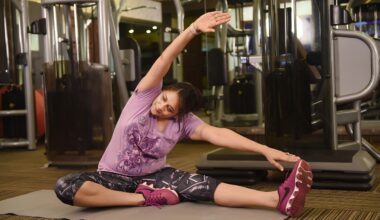Investigating the Kinematics of Turning Movements in Basketball
Understanding the kinematics of turning movements in basketball is crucial for athlete performance and injury prevention. Kinematics refers to the study of motion without considering the forces that cause it. In the context of basketball, turning movements are essential for effective gameplay, as athletes frequently change direction to evade defenders or reposition themselves for shooting. Analyzing these movements involves characterizing parameters such as speed, angle, and acceleration. Techniques like motion capture systems are utilized to gather accurate data, allowing for precise analysis. By employing videographic methods, researchers can review real-time footage while focusing on specific movement aspects. This information facilitates a better comprehension of the biomechanical principles behind turning. Consequently, athletes can use insights from kinematic analysis to optimize their techniques. Coaches can also refine training programs, emphasizing core and lower body strength that positively impacts balance and agility. By enhancing turning mechanics, players become more efficient in performing on-court tactics, leading to improved overall performance. Coaches are encouraged to integrate kinematic analysis into their training protocols to foster player development and ensure safer athletic practices.
One notable aspect of turning movements in basketball is the biomechanics of foot placement and ground reaction forces. The directions and angles of foot placement during a turn significantly influence the effectiveness of movement. Success in executing turns largely depends on aligning the center of mass with the intended direction. A deeper understanding of how players distribute their weight during these movements influences optimal training regimens. Research into gait and foot biomechanics shows that athletes benefit from specialized footwear designed to enhance traction and shock absorption while performing turns. Moreover, when considering foot placement, players must balance agility with stability. A key challenge involves maintaining acceleration throughout a turn. Training focused on improving this balance can ultimately contribute to superior on-court performance. Coaches should implement drills that emphasize rapid directional changes, improving not just speed but also accuracy in turns. Additionally, reinforcing proper footwork during practices can prevent injuries linked to improper turning mechanics. Such protective measures ensure long-term athlete health while enhancing performance metrics on the court. Utilizing advanced technology could further refine understanding of these sophisticated biomechanical dynamics.
The Role of Angular Momentum
Angular momentum plays a vital role in the kinematics of turning movements, allowing players to maintain balance and control during rapid directional shifts. In simple terms, angular momentum is the rotational equivalent of linear momentum. When executing a turn, athletes must generate sufficient angular momentum to change direction effectively while minimizing the risk of losing balance or falling. The distribution of mass, combined with the athlete’s velocity and pivot point, influences the angular momentum produced during turns. A deeper dive into the mechanics of angular momentum reveals how players utilize body positioning to enhance their turning capabilities. Specifically, the orientation of limbs and the position of the torso can either aid or hinder effective motion. By mastering the coordination of these factors, athletes can create a more efficient and controlled turning radius. Training that incorporates timing drills focusing on body alignment can aid in developing this skill. This not only improves agility but reduces potential risk factors for injuries that arise from poorly executed turns. Therefore, understanding angular momentum helps equip basketball players with tools to enhance their gameplay significantly.
Another significant factor influencing turning kinematics in basketball is the role of muscle activation and strength during movement. Recruitment of muscle groups affects not only performance but also injury risk during rapid maneuvering. Specific muscle groups are instrumental in enabling efficient turn execution. The hip flexors, glutes, and quadriceps are primarily responsible for generating the necessary force during turning. Activation patterns among these muscles can provide insights into how athletes optimize power output while maintaining stability. Furthermore, training regimens should emphasize strength training to develop these key muscles, promoting both explosiveness and endurance in players. Through targeted functional exercises such as resistance training, players can enhance muscle responsiveness and overall agility. These programs should balance strength with flexibility to ensure a comprehensive approach to turning mechanics. Stretching exercises contribute to muscle recovery and help maintain an athlete’s range of motion throughout games. Additionally, understanding the synchronization of muscle activation during turns can lead to the development of innovative training protocols. Such programs can maximize athletes’ efficiency while simultaneously lowering injury risk during competitive basketball play.
Impact of Technology on Kinematic Analysis
The advent of technology in sports science has revolutionized the study of kinematics in basketball. Advanced tools, including high-speed cameras, 3D motion analysis systems, and wearable sensors, allow researchers to capture intricate details of movement dynamics. These technological advancements provide invaluable data on the mechanics of turning movements. Collecting real-time data enhances the accuracy of biomechanical assessments, offering precise measurements of speed, force, and body positioning during turns. By utilizing machine learning algorithms on this data, analysts can identify patterns that optimize performance. Furthermore, this technology enables the development of virtual simulations, allowing athletes to visualize their movements and understand the biomechanics involved. Coaches can leverage these tools to give personalized feedback, refining techniques based on data-driven insights. Ultimately, the integration of technology into kinematic analysis facilitates improved training conditions for athletes and helps enhance the overall efficiency of turning movements. Regular assessments using advanced tools can ensure athletes maintain high performance standards while reducing the chance of injuries linked to improper mechanics during gameplay. Continuous evolution in these technological applications will surely propel future research in biomechanics.
In conclusion, the kinematics of turning movements in basketball is a multifaceted field that combines various aspects of biomechanics, technology, and training. As more studies center around this area, the knowledge gained can greatly influence how athletes approach their training regimens. The insights provided from kinematic analysis can lead to personalized training that accounts for individual strengths and weaknesses. Coaches who adapt their strategies based on player data will likely see enhanced performance across their teams. Additionally, understanding the principles behind angular momentum, muscle activation, and foot biomechanics promotes safer athletic practices. By integrating new technologies into training, athletes can continuously improve their techniques and skill sets, giving them a competitive edge. Moreover, ongoing research will foster an environment where injury prevention becomes paramount, allowing athletes to maximize their performance without compromising health. The increasing knowledge within biomechanics will foster a new generation of basketball players who understand the intricacies behind their movements. Finally, making educated changes based on kinematic principles will undoubtedly enhance the sport, making basketball safer and more enjoyable for everyone involved.
Recommendations for future research include delving deeper into the interplay between fatigue and kinematic performance during turning movements. Fatigue can significantly diminish an athlete’s ability to execute proper mechanics, increasing the likelihood of injury. Investigating how muscle fatigue affects force generation and balance during a turn can yield vital insights for training protocols. Future studies should also explore gender differences in kinematics during basketball movements, as biomechanical responses may vary significantly. Understanding these differences can help tailor training programs more effectively across diverse athlete populations. Moreover, expanding upon existing data regarding footwear and its influence on biomechanics during turning could reveal beneficial findings. Athletes’ performance can be optimized by studying the materials and designs of shoes that enhance grip and minimize friction. Engaging in cross-disciplinary research, involving experts in sports science, kinesiology, and engineering, can further enrich understanding of basketball kinematics. With continuous refinement of techniques and technology, future investigations will undoubtedly uncover new avenues to enhance player performance and safety on the court. Ultimately, fostering an interdisciplinary approach will yield a deeper understanding of complex movement mechanics in basketball, leading to substantial advancements in athletic training and execution.
Final Thoughts on Kinematics in Basketball
The realm of kinematics in basketball is vast and requires ongoing exploration to unlock its full potential. Coaches and players alike can benefit from understanding the biomechanics behind performance. Recognizing the factors influencing turning movements, muscle activation, and technology integration enhances competitive edge in the sport. Training programs should highlight the complexity and sophistication of basketball gameplay and adapt to this understanding. As more advancements arise in biomechanical analysis and technological applications, the potential for improved athletic performance will only expand. Therefore, continuous education surrounding these developments is crucial. Engaging with athletes about the importance of biomechanics fosters a culture of awareness that can be quite beneficial. Ultimately, creating an environment rooted in knowledge surrounding kinematics can lead to safer practices and elevated performance levels among basketball players. As we move forward, the focus on this dynamic field remains critical for both athlete safety and performance enhancement. By encouraging research, education, and technology use, the basketball community can continue fostering excellence. Basketball can thrive through understanding and innovation in the kinematics of turning movements.


